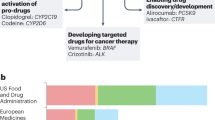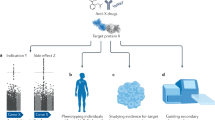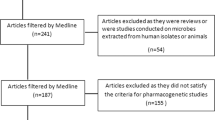Abstract
The current enthusiasm for pharmacogenetics draws much of its inspiration from the relatively few examples of polymorphisms that have marked and seemingly clinically relevant effects on drug response. In this regard, pharmacogenetic research has paralleled the study of human disease, which has enjoyed success in identifying mutations underlying mendelian conditions. Progress in deciphering the genetics of complex diseases, involving the interaction of multiple genes with each other and with the environment has been considerably less successful. In most instances, drug responses will probably also prove to be complex, influenced by both the environment and multiple genetic factors. For pharmacogenetics to deliver on its potential, this complexity will need to be recognized and accommodated, both in basic research and in clinical application of pharmacogenetics. As the attention of researchers begins to shift toward more systematic pharmacogenetic investigations, we suggest some priorities and standards for pharmacogenetic research.
This is a preview of subscription content, access via your institution
Access options
Subscribe to this journal
Receive 12 print issues and online access
$209.00 per year
only $17.42 per issue
Buy this article
- Purchase on Springer Link
- Instant access to full article PDF
Prices may be subject to local taxes which are calculated during checkout
Similar content being viewed by others
References
Goldstein, D.B., Tate, S.K. & Sisodiya, S.M. Pharmacogenetics goes genomic. Nat. Rev. Genet. 4, 937–947 (2003).
Strittmatter, W.J. et al. Apolipoprotein E: high-avidity binding to beta-amyloid and increased frequency of type 4 allele in late-onset familial Alzheimer disease. Proc. Natl. Acad. Sci. USA 90, 1977–1981 (1993).
Conley, R.R. & Kelly, D.L. Management of treatment resistance in schizophrenia. Biol. Psychiatry 50, 898–911 (2001).
Meltzer, H.Y. & Okayli, G. Reduction of suicidality during clozapine treatment of neuroleptic-resistant schizophrenia: impact on risk-benefit assessment. Am. J. Psychiatry 152, 183–190 (1995).
Honigfeld, G., Arellano, F., Sethi, J., Bianchini, A. & Schein, J. Reducing clozapine-related morbidity and mortality: 5 years of experience with the Clozaril National Registry. J. Clin. Psychiatry 59 Suppl., 3–7 (1998).
Duggan, A., Warner, J., Knapp, M. & Kerwin, R. Modelling the impact of clozapine on suicide in patients with treatment-resistant schizophrenia in the UK. Br. J. Psychiatry 182, 505–508 (2003).
Shah, R.R. Pharmacogenetic aspects of drug-induced torsade de pointes: potential tool for improving clinical drug development and prescribing. Drug Saf. 27, 145–172 (2004).
Wolbrette, D.L. Drugs that cause torsades de pointes and increase the risk of sudden cardiac death. Curr. Cardiol. Rep. 6, 379–384 (2004).
Roses, A.D. Pharmacogenetics and drug development: the path to safer and more effective drugs. Nat. Rev. Genet. 5, 645–656 (2004).
Parker, S.L., Tong, T., Bolden, S. & Wingo, P.A. Cancer statistics, 1997. CA Cancer J. Clin. 47, 5–27 (1997).
Lynch, T.J. et al. Activating mutations in the epidermal growth factor receptor underlying responsiveness of non-small-cell lung cancer to gefitinib. N. Engl. J. Med. 350, 2129–2139 (2004).
Paez, J.G. et al. EGFR mutations in lung cancer: correlation with clinical response to gefitinib therapy. Science 304, 1497–1500 (2004).
Fischer, O.M., Streit, S., Hart, S. & Ullrich, A. Beyond Herceptin and Gleevec. Curr. Opin. Chem. Biol. 7, 490–495 (2003).
Weinshilboum, R. Inheritance and drug response. N. Engl. J. Med. 348, 529–537 (2003).
Schaeffeler, E. et al. Comprehensive analysis of thiopurine S-methyltransferase phenotype-genotype correlation in a large population of German-Caucasians and identification of novel TPMT variants. Pharmacogenetics 14, 407–417 (2004).
Flowers, C.R. & Veenstra, D. The role of cost-effectiveness analysis in the era of pharmacogenomics. Pharmacoeconomics 22, 481–493 (2004).
Strauss, J.F. III & Kafrissen, M. Waiting for the second coming. Nature 432, 43–45 (2004).
Roses, A.D., Burns, D.K., Chissoe, S., Middleton, L. & St Jean, P. Disease-specific target selection: a critical first step down the right road. Drug Discov. Today 10, 177–189 (2005).
Nebert, D.W., Jorge-Nebert, L. & Vesell, E.S. Pharmacogenomics and “individualized drug therapy”: high expectations and disappointing achievements. Am. J. Pharmacogenomics 3, 361–370 (2003).
Nebert, D.W. & Vesell, E.S. Advances in pharmacogenomics and individualized drug therapy: exciting challenges that lie ahead. Eur. J. Pharmacol. 500, 267–280 (2004).
Shorvon, S., Perucca, E., Fish, S. & Dodson, E. The Treatment of Epilepsy (Blackwell Science, Oxford, 2004).
Tate, S.K. et al. Genetic predictors of the maximum doses patients receive during clinical use of the anti-epileptic drugs carbamazepine and phenytoin. Proc. Natl. Acad. Sci. USA 102, 5507–5512 (2005).
Rajput, A.H. et al. Clinical-pathological study of levodopa complications. Mov. Disord. 17, 289–296 (2002).
Krajinovic, M. et al. Role of polymorphisms in MTHFR and MTHFD1 genes in the outcome of childhood acute lymphoblastic leukemia. Pharmacogenomics J. 4, 66–72 (2004).
Dervieux, T. et al. Polyglutamation of methotrexate with common polymorphisms in reduced folate carrier, aminoimidazole carboxamide ribonucleotide transformylase, and thymidylate synthase are associated with methotrexate effects in rheumatoid arthritis. Arthritis Rheum. 50, 2766–2774 (2004).
Holleman, A. et al. Gene-expression patterns in drug-resistant acute lymphoblastic leukemia cells and response to treatment. N. Engl. J. Med. 351, 533–542 (2004).
Kager, L. et al. Folate pathway gene expression differs in subtypes of acute lymphoblastic leukemia and influences methotrexate pharmacodynamics. J. Clin. Invest. 115, 110–117 (2005).
Zembutsu, H. et al. Genome-wide cDNA microarray screening to correlate gene expression profiles with sensitivity of 85 human cancer xenografts to anticancer drugs. Cancer Res. 62, 518–527 (2002).
Watters, J.W., Kraja, A., Meucci, M.A., Province, M.A. & McLeod, H.L. Genome-wide discovery of loci influencing chemotherapy cytotoxicity. Proc. Natl. Acad. Sci. USA 101, 11809–11814 (2004).
Xiao, Z. et al. Serum proteomic profiles suggest celecoxib-modulated targets and response predictors. Cancer Res. 64, 2904–2909 (2004).
Botstein, D. & Risch, N. Discovering genotypes underlying human phenotypes: past successes for mendelian disease, future approaches for complex disease. Nat. Genet. 33 Suppl. 228–237 (2003).
Johnson, G.C. et al. Haplotype tagging for the identification of common disease genes. Nat. Genet. 29, 233–237 (2001).
Ke, X. et al. Efficiency and consistency of haplotype tagging of dense SNP maps in multiple samples. Hum. Mol. Genet. 13, 2557–2565 (2004).
Liu, N. et al. Haplotype block structures show significant variation among populations. Genet. Epidemiol. 27, 385–400 (2004).
Ahmadi, K.R. et al. A single-nucleotide polymorphism tagging set for human drug metabolism and transport. Nat. Genet. 37, 84–89 (2005).
Reich, D.E. et al. Linkage disequilibrium in the human genome. Nature 411, 199–204 (2001).
Goldstein, D.B., Ahmadi, K.R., Weale, M.E. & Wood, N.W. Genome scans and candidate gene approaches in the study of common diseases and variable drug responses. Trends Genet. 19, 615–622 (2003).
Stumpf, M.P. & Goldstein, D.B. Demography, recombination hotspot intensity, and the block structure of linkage disequilibrium. Curr. Biol. 13, 1–8 (2003).
Kruglyak, L. Prospects for whole-genome linkage disequilibrium mapping of common disease genes. Nat. Genet. 22, 139–144 (1999).
Li, H. A permutation procedure for the haplotype method for identification of disease-predisposing variants. Ann. Hum. Genet. 65, 189–196 (2001).
Reich, D.E. & Goldstein, D.B. Detecting association in a case-control study while correcting for population stratification. Genet. Epidemiol. 20, 4–16 (2001).
Devlin, B. & Roeder, K. Genomic control for association studies. Biometrics 55, 997–1004 (1999).
Bacanu, S.A., Devlin, B. & Roeder, K. Association studies for quantitative traits in structured populations. Genet. Epidemiol. 22, 78–93 (2002).
Goldstein, D.B. Pharmacogenetics in the laboratory and the clinic. N. Engl. J. Med. 348, 553–556 (2003).
Soranzo, N. et al. Identifying candidate causal variants responsible for altered activity of the ABCB1 multidrug resistance gene. Genome Res. 14, 1333–1344 (2004).
Boffelli, D. et al. Phylogenetic shadowing of primate sequences to find functional regions of the human genome. Science 299, 1391–1394 (2003).
Ovcharenko, I., Boffelli, D. & Loots, G.G. eShadow: a tool for comparing closely related sequences. Genome Res. 14, 1191–1198 (2004).
Jiang, Z. et al. Toward the evaluation of function in genetic variability: characterizing human SNP frequencies and establishing BAC-transgenic mice carrying the human CYP1A1_CYP1A2 locus. Hum. Mutat. 25, 196–206 (2005).
Shah, R.R. Pharmacogenetics in drug regulation; strengths and limitations. Proc. R. Soc. Lond. B Biol. Sci. (in the press).
Lesko, L.J. & Woodcock, J. Translation of pharmacogenomics and pharmacogenetics: a regulatory perspective. Nat. Rev. Drug Discov. 3, 763–769 (2004).
Kirchheiner, J. et al. Pharmacogenetics of antidepressants and antipsychotics: the contribution of allelic variations to the phenotype of drug response. Mol. Psychiatry 9, 442–473 (2004).
Tate, S.K. & Goldstein, D.B. Will tomorrow's medicines work for everyone? Nat. Genet. 36, S34–S42 (2004).
McGough, J.J. et al. Pharmacokinetics of SLI381 (ADDERALL XR), an extended-release formulation of Adderall. J. Am. Acad. Child Adolesc. Psychiatry 42, 684–691 (2003).
Camilleri, M. et al. Serotonin-transporter polymorphism pharmacogenetics in diarrhea-predominant irritable bowel syndrome. Gastroenterology 123, 425–432 (2002).
Berson, A. et al. Toxicity of alpidem, a peripheral benzodiazepine receptor ligand, but not zolpidem, in rat hepatocytes: role of mitochondrial permeability transition and metabolic activation. J. Pharmacol. Exp. Ther. 299, 793–800 (2001).
Ishikawa, C. et al. A frameshift variant of CYP2C8 was identified in a patient who suffered from rhabdomyolysis after administration of cerivastatin. J. Hum. Genet. 49, 582–585 (2004).
Michalski, C. et al. A naturally occurring mutation in the SLC21A6 gene causing impaired membrane localization of the hepatocyte uptake transporter. J. Biol. Chem. 277, 43058–43063 (2002).
Chung, W.H. et al. Medical genetics: a marker for Stevens-Johnson syndrome. Nature 428, 486 (2004).
Napolitano, C. et al. Evidence for a cardiac ion channel mutation underlying drug-induced QT prolongation and life-threatening arrhythmias. J. Cardiovasc. Electrophysiol. 11, 691–696 (2000).
Makita, N. et al. Drug-induced long-QT syndrome associated with a subclinical SCN5A mutation. Circulation 106, 1269–1274 (2002).
Ni, W., Li, M.W., Thakali, K., Fink, G.D. & Watts, S.W. The fenfluramine metabolite (+)-norfenfluramine is vasoactive. J. Pharmacol. Exp. Ther. 309, 845–852 (2004).
Gross, A.S., Phillips, A.C., Rieutord, A. & Shenfield, G.M. The influence of the sparteine/debrisoquine genetic polymorphism on the disposition of dexfenfluramine. Br. J. Clin. Pharmacol. 41, 311–317 (1996).
Belohlavkova, S., Simak, J., Kokesova, A., Hnilickova, O. & Hampl, V. Fenfluramine-induced pulmonary vasoconstriction: role of serotonin receptors and potassium channels. J. Appl. Physiol. 91, 755–761 (2001).
Blanpain, C. et al. Serotonin 5-HT(2B) receptor loss of function mutation in a patient with fenfluramine-associated primary pulmonary hypertension. Cardiovasc. Res. 60, 518–528 (2003).
Humbert, M. et al. BMPR2 germline mutations in pulmonary hypertension associated with fenfluramine derivatives. Eur. Respir. J. 20, 518–523 (2002).
Zhang, J.Y., Zhan, J., Cook, C.S., Ings, R.M. & Breau, A.P. Involvement of human UGT2B7 and 2B15 in rofecoxib metabolism. Drug Metab. Dispos. 31, 652–658 (2003).
Donger, C. et al. KVLQT1 C-terminal missense mutation causes a forme fruste long-QT syndrome. Circulation 96, 2778–2781 (1997).
Ford, G.A., Wood, S.M. & Daly, A.K. CYP2D6 and CYP2C19 genotypes of patients with terodiline cardiotoxicity identified through the yellow card system. Br. J. Clin. Pharmacol. 50, 77–80 (2000).
Acuna, G. et al. Pharmacogenetic analysis of adverse drug effect reveals genetic variant for susceptibility to liver toxicity. Pharmacogenomics J. 2, 327–334 (2002).
Kumashiro, R. et al. Association of troglitazone-induced liver injury with mutation of the cytochrome P450 2C19 gene. Hepatol. Res. 26, 337–342 (2003).
Watanabe, I. et al. A study to survey susceptible genetic factors responsible for troglitazone-associated hepatotoxicity in Japanese patients with type 2 diabetes mellitus. Clin. Pharmacol. Ther. 73, 435–455 (2003).
Liguori, M.J. et al. Microarray analysis in human hepatocytes suggests a mechanism for hepatotoxicity induced by trovafloxacin. Hepatology 41, 177–186 (2005).
Wong, D., Wang, M., Cheng, Y. & Fitzgerald, G.A. Cardiovascular hazard and non-steroidal anti-inflammatory drugs. Curr. Opin. Pharmacol. 5, 204–210 (2005).
Cipollone, F. et al. A polymorphism in the cyclooxygenase 2 gene as an inherited protective factor against myocardial infarction and stroke. J. Am. Med. Assoc. 291, 2221–2228 (2004).
Shah, R.R. Mechanistic basis of adverse drug reactions: the perils of inappropriate dose schedules. Expert Opinion on Drug Safety 4, 103–128 (2005).
Acknowledgements
We thank S. Sisodiya, R. Shah, S. Tate, S. Huang and H. Willard for suggestions and critical reading of the manuscript. A.G.M.'s work is supported by NIEHS Ecogenetics Center Grant P30ES07033.
Author information
Authors and Affiliations
Ethics declarations
Competing interests
The authors declare no competing financial interests.
Rights and permissions
About this article
Cite this article
Need, A., Motulsky, A. & Goldstein, D. Priorities and standards in pharmacogenetic research. Nat Genet 37, 671–681 (2005). https://doi.org/10.1038/ng1593
Published:
Issue Date:
DOI: https://doi.org/10.1038/ng1593
This article is cited by
-
Individualized medicine enabled by genomics in Saudi Arabia
BMC Medical Genomics (2015)
-
A national clinical decision support infrastructure to enable the widespread and consistent practice of genomic and personalized medicine
BMC Medical Informatics and Decision Making (2009)
-
The Medical and Economic Roles of Pipeline Pharmacogenetics: Alzheimer's Disease as a Model of Efficacy and HLA-B*5701 as a Model of Safety
Neuropsychopharmacology (2009)



